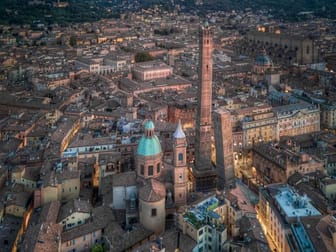Basilica di San Francesco





Ask ThatchGPT
Suggest a local expert to plan my trip
Suggest an unique itinerary for my Italy trip
What foods do Italy locals eat
What are some true hidden gems in Italy
Help me brainstorm trip ideas for Italy
Help me plan a family-friendly trip to Italy
What people say
Pedro Pereira
Available for hire
"The church, the first example in Italy of Gothic style of French origin, was built in the 13th century on the initiative of the Franciscan community that had settled in the city since 1218 with Bernardo di Quintavalle, one of the first disciples of Saint Francis. The church that can be admired today is a pastiche of different styles ranging from Romanesque to late Gothic and early Renaissance.
Noteworthy are the high façade of Roman-Gothic forms and the apse with the two bell towers and the flying buttresses of the radial chapels at whose feet stand the 13th-century mausoleums of the glossators Accursio, Odofredo and Rolandino de' Romanzi. Inside, of austere and grandiose orchestration, the magnificent marble altarpiece of the high altar stands out, sculpted between 1388 and 1393 by the Venetians Jacobello and Pier Paolo dalle Masegne.
Worthy of note are various sepulchral monuments along the walls, including the tomb of Pope Alexander V and the Romanesque Muzzarelli chapel, and the cloisters (14th-15th century) of the adjacent convent. Inside the complex there is also the Library of San Francesco with a collection of 39,000 volumes and pamphlets, the Rubbiani Archive, the Historical Archive of the Province of Bologna of the Friars Minor Conventual and the Musical Archive."
Read more in:
Petra Hus
Available for hire
"The Basilica di San Francesco in Bologna is a stunning example of Italian Gothic architecture, located near Piazza Malpighi. Built between the 13th and 14th centuries, this church is dedicated to St. Francis of Assisi and is one of Bologna's most important religious landmarks.
Key features of the Basilica include:
Gothic Architecture: The Basilica has a beautiful Gothic façade with a large rose window and pointed arches. The interior features soaring vaulted ceilings and intricate stained glass.
Tombs of the Glossatori: In the square outside the church, there are several medieval tombs of famous "Glossators" (legal scholars), who were important figures in Bologna's history, especially during its development as a center for legal studies.
Chapels and Frescoes: Inside, you'll find numerous chapels, some adorned with frescoes from the medieval period. The Basilica has also undergone several restorations that highlight both Gothic and Renaissance elements.
Cloister: The peaceful cloister and surrounding gardens are serene spaces where visitors can relax and reflect."
Read more in:
Mentioned in these guides
About Basilica di San Francesco
Get the inside scoop on Basilica di San Francesco from local experts, travel creators, and tastemakers. Browse genuine trip notes, Basilica di San Francesco reviews, photos, travel guides, and itineraries from real travelers and plan your trip with confidence.
Phone
Save this spot for later or start mapping out a new trip today
Try our AI Travel Assistant and get instant answers to any questions about your trip.
Ask ThatchGPT


